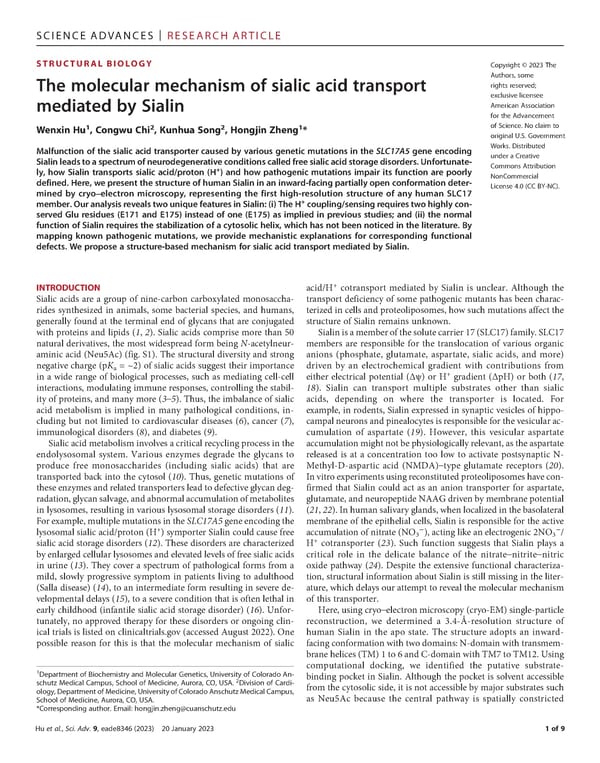The molecular mechanism of sialic acid transport mediated by Sialin
SCIENCEADVANCES | RESEARCHARTICLE STRUCTURALBIOLOGY Copyright © 2023 The Authors, some The molecular mechanism of sialic acid transport rights reserved; exclusive licensee mediated by Sialin American Association for the Advancement 1 2 2 1 of Science. No claim to Wenxin Hu , Congwu Chi , Kunhua Song , Hongjin Zheng * original U.S. Government Malfunction of the sialic acid transporter caused by various genetic mutations in the SLC17A5 gene encoding Works. Distributed Sialinleadstoaspectrumofneurodegenerativeconditionscalledfreesialicacidstoragedisorders.Unfortunate- under a Creative + CommonsAttribution ly, how Sialin transports sialic acid/proton (H ) and how pathogenic mutations impair its function are poorly NonCommercial defined. Here, we present the structure of human Sialin in an inward-facing partially open conformation deter- License 4.0 (CC BY-NC). mined by cryo–electron microscopy, representing the first high-resolution structure of any human SLC17 member.OuranalysisrevealstwouniquefeaturesinSialin:(i)TheH+coupling/sensingrequirestwohighlycon- served Glu residues (E171 and E175) instead of one (E175) as implied in previous studies; and (ii) the normal function of Sialin requires the stabilization of a cytosolic helix, which has not been noticed in the literature. By mapping known pathogenic mutations, we provide mechanistic explanations for corresponding functional defects. We propose a structure-based mechanism for sialic acid transport mediated by Sialin. INTRODUCTION acid/H+ cotransport mediated by Sialin is unclear. Although the Sialic acids are a group of nine-carbon carboxylated monosaccha- transport deficiency of some pathogenic mutants has been charac- rides synthesized in animals, some bacterial species, and humans, terized in cells and proteoliposomes, how such mutations affect the generally found at the terminal end of glycans that are conjugated structure of Sialin remains unknown. with proteins and lipids (1, 2). Sialic acids comprise more than 50 Sialin is a memberofthesolutecarrier17(SLC17)family.SLC17 natural derivatives, the most widespread form being N-acetylneur- members are responsible for the translocation of various organic aminic acid (Neu5Ac) (fig. S1). The structural diversity and strong anions (phosphate, glutamate, aspartate, sialic acids, and more) negative charge (pKa = ~2) of sialic acids suggest their importance driven by an electrochemical gradient with contributions from in a wide range of biological processes, such as mediating cell-cell either electrical potential (Δψ) or H+ gradient (ΔpH) or both (17, interactions, modulating immune responses, controlling the stabil- 18). Sialin can transport multiple substrates other than sialic ity of proteins, and many more (3–5). Thus, the imbalance of sialic acids, depending on where the transporter is located. For acid metabolism is implied in many pathological conditions, in- example, in rodents, Sialin expressed in synaptic vesicles of hippo- cluding but not limited to cardiovascular diseases (6), cancer (7), campalneuronsandpinealocytesisresponsibleforthevesicularac- immunological disorders (8), and diabetes (9). cumulation of aspartate (19). However, this vesicular aspartate Sialic acid metabolism involves a critical recycling process in the accumulationmightnotbephysiologicallyrelevant,astheaspartate endolysosomal system. Various enzymes degrade the glycans to released is at a concentration too low to activate postsynaptic N- produce free monosaccharides (including sialic acids) that are Methyl-D-aspartic acid (NMDA)–type glutamate receptors (20). transported back into the cytosol (10). Thus, genetic mutations of Invitroexperimentsusingreconstitutedproteoliposomeshavecon- these enzymesandrelatedtransportersleadtodefectiveglycandeg- firmed that Sialin could act as an anion transporter for aspartate, radation,glycansalvage,andabnormalaccumulationofmetabolites glutamate, andneuropeptideNAAGdrivenbymembranepotential in lysosomes, resulting in various lysosomal storage disorders (11). (21, 22). In human salivary glands, when localized in the basolateral Forexample,multiplemutationsintheSLC17A5geneencodingthe membraneoftheepithelial cells, Sialin is responsible for the active + − − lysosomal sialic acid/proton (H ) symporter Sialin could cause free accumulation of nitrate (NO ), acting like an electrogenic 2NO / + 3 3 sialic acid storage disorders (12). These disorders are characterized H cotransporter (23). Such function suggests that Sialin plays a byenlargedcellular lysosomes and elevated levels of free sialic acids critical role in the delicate balance of the nitrate–nitrite–nitric in urine (13). They cover a spectrum of pathological forms from a oxide pathway (24). Despite the extensive functional characteriza- mild, slowly progressive symptom in patients living to adulthood tion, structural information about Sialin is still missing in the liter- (Salla disease) (14), to an intermediate form resulting in severe de- ature, which delays our attempt to reveal the molecular mechanism velopmental delays (15), to a severe condition that is often lethal in of this transporter. early childhood (infantile sialic acid storage disorder) (16). Unfor- Here, using cryo–electron microscopy (cryo-EM) single-particle tunately, no approved therapy for these disorders or ongoing clin- reconstruction, we determined a 3.4-Å-resolution structure of ical trials is listed on clinicaltrials.gov (accessed August 2022). One human Sialin in the apo state. The structure adopts an inward- possible reason for this is that the molecular mechanism of sialic facing conformationwithtwodomains:N-domainwithtransmem- branehelices(TM)1to6andC-domainwithTM7toTM12.Using computational docking, we identified the putative substrate- 1Department of Biochemistry and Molecular Genetics, University of Colorado An- binding pocket in Sialin. Although the pocket is solvent accessible schutz Medical Campus, School of Medicine, Aurora, CO, USA. 2Division of Cardi- fromthecytosolic side, it is not accessible by major substrates such ology, DepartmentofMedicine,UniversityofColoradoAnschutzMedicalCampus, as Neu5Ac because the central pathway is spatially constricted School of Medicine, Aurora, CO, USA. *Corresponding author. Email: [email protected] Huetal., Sci. Adv. 9, eade8346 (2023) 20 January 2023 1of9
 The molecular mechanism of sialic acid transport mediated by Sialin Page 2
The molecular mechanism of sialic acid transport mediated by Sialin Page 2